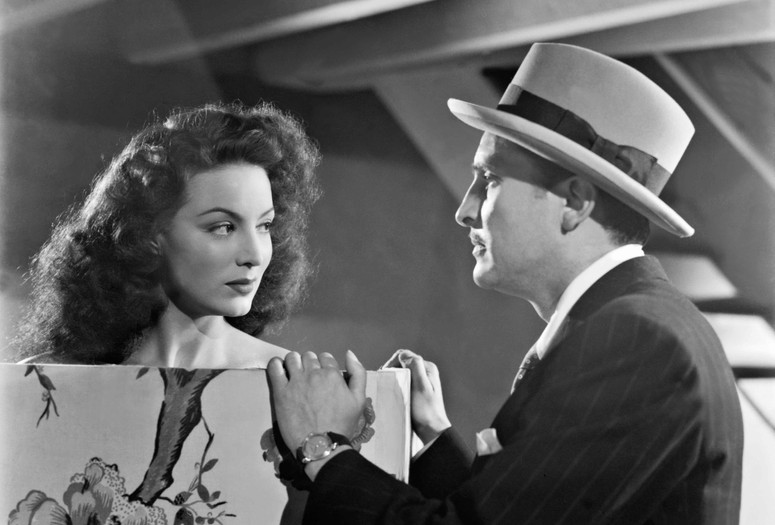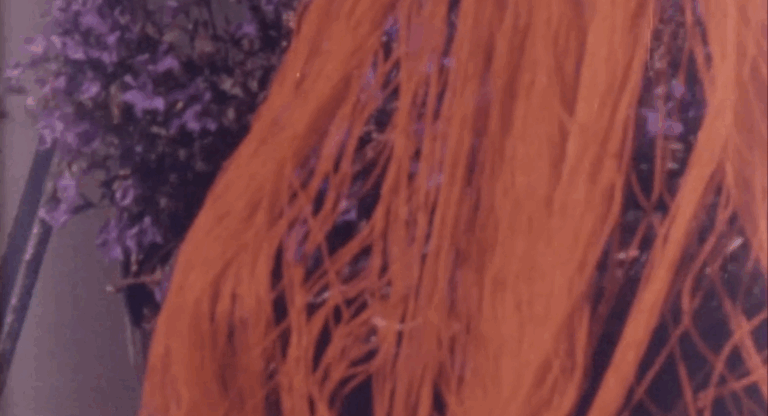Any lover who has ever felt that they must be inventing love will find a confirmation of their suspicions in the Mexican melodramas of Roberto Gavaldón. Working in the midst of Mexico’s cinematic Golden Age, Gavaldón found a noir-ish style that transformed the classic melodrama into something that was both sumptuous and unsettling. Understanding the genre as more than an expression of pure feeling, his true protagonist was not any individual, but the clash between desire, duty, and fate that strangles all lovers. If his handcrafted atmosphere of shadows and silence finds its apotheosis in The Kneeling Goddess (1947), it is because of the presence of someone who can turn every glance into a wound: the actress María Félix.
Gavaldón introduces her as Raquel, a nightclub singer who is in the middle of saying farewell to her lover. The man in question is Antonio (Arturo de Córdova), a wealthy industrialist, and they are tied up in goodbyes at the foot of an airplane. Despite their best efforts to voice their romance, distance and law keep them apart, as Antonio is married. Soon after, each one will decide, without consulting the other, that this farewell was their last one. And no sooner than later, they will also discover that physical attachment is no match for their truest form of haunting: desire.
Antonio’s ill wife Elena (Rosario Granados) sends him to search for a statue to decorate their courtyard and, incapable of resisting his desire, Antonio ends up acquiring a kneeling statue modeled in the image and likeness of Raquel that he plops in the middle of their home—a reminder that some things are inevitable. The naked statue is seen from every angle of the house—a silent, but evocative haunt in every shot of the film. Meanwhile, the real Raquel is an imposing presence of her own, threatening Antonio's marriage by crashing one of the couple’s house parties, but more effortlessly, by just being there, sliding gracefully in front of the camera draped in elegant suits and gowns. María Félix, both a muse and a menace, recognizes that she is not merely one of those women reduced to a face—one of those classic visages to be framed and stilled in tape or celluloid—but, rather, a force of nature that subjugates everything in its path.
As a true Golden Age actress, her composed face preserves the serenity of someone well aware of their irreplaceability, while delivering a calculated control in revealing glimpses of vulnerability. Her stillness is often more unsettling than her movement, as she recognizes an averted gaze can be more seductive than a direct glance. Her eyes even say something when she chooses to close them, like when she hugs her lover and keeps her face out of sight, weighted with the mortifying truth that is a risk for every goddess: to love the wrong man. And yet, her eyes also open wide during moments of surprise, tricking us into thinking that she is not able to control everything. Nonetheless, Raquel, who has worked compromising jobs posing for artists in the nude, is as confident in who she is as what she feels. Every word she speaks sounds both firm and vulnerable, like a confession, conveying the truth that love is nothing to be ashamed of—not even for women whom society demands remain untouched.
The statue, then, as a window into her soul, remains in a posture of unstable immobility: kneeling, leaning into itself twice with its arms held back. One arm, extended backwards, is fixed on solid ground, propelling the bare torso forward for anyone who dares fall into primal temptation. The other, raised above the head, tilts the face inward, withdrawing into itself. As a man, Antonio wrestles with the belief that all that is true is what he can—or cannot—control or possess. He will fail in his attempt to escape the fate desire has planned for him. Dispossessed, turned into a statue and duplicated, Raquel’s relationship with desire is, for better or worse, different. In Spanish, only one letter separates Félix from fénix (phoenix). And like the mythological creature that rises from its ashes, The Kneeling Goddess reminds us that desire tends equally toward destruction as it does to birth. By falling in and out of love, Raquel and Antonio play the game of reinventing themselves while playing with fire. After all, there is no other way to love.
The Kneeling Goddess screens this afternoon, July 19, and on July 26, at MoMA as part of the series “María Félix: La Doña.”



